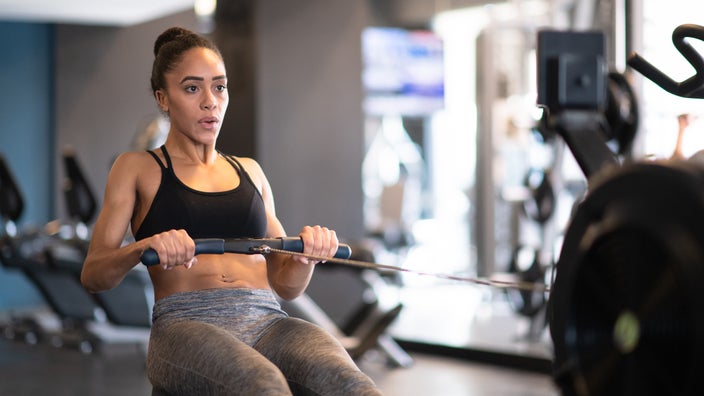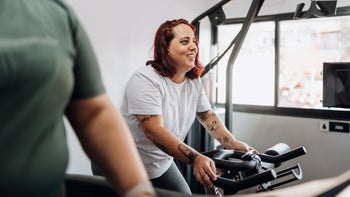
How to Use a Rowing Machine for a Total-Body Workout
Key takeaways:
Rowing machines can provide a low-impact, total-body workout.
There are four phases of the rowing stroke: catch, drive, finish, and recovery.
Pushing powerfully with your legs is the best way to increase the intensity of the workout.

When it comes to the cardio section at the gym, most people are familiar with treadmills, exercise bikes, and elliptical machines. But rowing machines are also a great tool for getting a low-impact, total-body workout.
The rowing machine can be intimidating for beginners. Unlike other forms of cardio, most people haven’t had experience rowing in a real boat. So using the indoor rowing machine may be entirely unfamiliar. A few simple tips can help you understand how to get the most out of it.
What are the benefits of using a rowing machine?
There are several key benefits of using a rowing machine:
Offers low-impact exercise: A rowing machine provides a low-impact workout because your body is supported by the seat. This makes it a good form of cardio for people with joint pain.
Provides a total-body workout: The rowing machine offers a total-body workout by engaging multiple muscle groups in the upper and lower body. This includes key muscles in your legs, arms, chest, and back.
Strengthens core muscles: Rowing uses your core muscles, including the abs, glutes, and low-back muscles.
Combines aerobics and strength training: Rowing is an efficient exercise because it provides an aerobic workout that can boost your cardiorespiratory fitness while simultaneously strengthening your muscles.
Caters to all fitness levels: You can adjust the resistance on a rowing machine to make the workout appropriate for different fitness levels.
How to use a rowing machine
There are four phases of the rowing stroke. The phases are performed in one continuous motion over and over as you row. Knowing the breakdown of each phase helps you focus on engaging the right muscles for proper form.
Search and compare options
Here’s how to perform each phase.
1. Catch
The catch is the start of the rowing stroke. The seat will be all the way forward towards the console.
To prepare for the catch:
Your knees should be bent so that they are coming up towards your chest. Your shins should be perpendicular to the floor.
Lean slightly forward with your torso by hinging at the hips.
2. Drive
The drive phase is the powerful part of the rowing stroke. It is when most of the pressing motion occurs. The drive involves moving your legs, core, and then arms in one fluid but sequential order.
Press your feet against the foot plates of the rowing machine as powerfully as you can.
Straighten your knees to extend your legs fully.
The seat should slide backwards down the rail of the rowing machine.
After pressing with your legs, hinge back with your torso so that you are now sitting upright.
Use your upper body to pull the handlebar in towards your chest.
3. Finish
The finish is the end point of the rowing stroke. You will be the farthest away from the monitor.
Use your core muscles to hinge your torso back even more.
If you’re looking at your body from the side, your torso should lean to 11 o’clock at the catch, 12 o’clock at the drive, and 1 o’clock at the finish.
Use the momentum of the explosive leg drive to bend your elbows and bring the handlebar all the way into your chest.
Read more like this
Explore these related articles, suggested for readers like you.
4. Recovery
The recovery phase brings your body back to the catch position at the front of the machine. It is the reverse of the drive.
Extend your arms so that the handlebar reaches towards the monitor of the rowing machine.
Hinge your torso forward.
Bend your knees to slide back to the front of the machine.
Rowing terms to know
The most important terms to know for your rowing workouts are:
Split: Your split refers to your rowing speed. The unit of measure is 500 meters. So, your split refers to how fast you are able to cover 500 meters. The lower your split, the better. Beginners might have a split of 3:30/500m, whereas experienced rowers work their split down to under 2:00. A split of 3:30 means it takes 3 minutes and 30 seconds to row 500 meters.
Rhythm: Your rhythm refers to your rowing pace. When you walk, your cadence is the number of steps you take per minute. When you row, your rhythm is the number of strokes you make –– pulling the handle to move up and down the rail –– per minute.
Watts: The rowing machine will display watts, which is a unit of power. Your watts on a rowing machine are determined by your rhythm (strokes per minute), resistance, and how explosively you push and pull. So you want this number to be as high as possible.
Tips for proper rowing machine form
Here are a few helpful tips to avoid common beginner mistakes:
Don’t round your shoulders. Keep your core engaged and sit upright with good posture. Many people hunch or slouch forward, but this isn’t good for your back. It can also reduce the efficiency of your stroke.
Engage your core throughout the rowing stroke.
Use a light grip on the handlebar.
Adjust the footplates. If the foot plates can be moved up or down, raise or lower them until the foot strap is lined up along the widest part of your foot. This is usually the ball of your foot.
Slow down. Many new rowers think you need to increase the rhythm (more strokes per minute) to row faster. The key to getting a better split is actually pushing harder with your legs.
Use your legs, not your arms. Although you need to use your arms to pull the handlebar, pressing with your legs as hard as you can will help you row faster. Engage your quads and glutes to push at the start of each stroke. Focus on this instead of pulling harder with your upper body.
The bottom line
Learning how to use the rowing machine can be challenging for beginners. However, with a little patience and practice, you can master the technique. And it’s worth it: Rowing will give you a great total-body workout.
Why trust our experts?



References
Ingham, S. A., et al. (2008). Physiological and performance effects of low- versus mixed-intensity rowing training. Medicine & Science in Sports & Exercise.



























